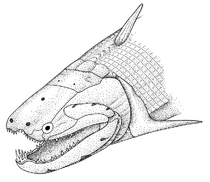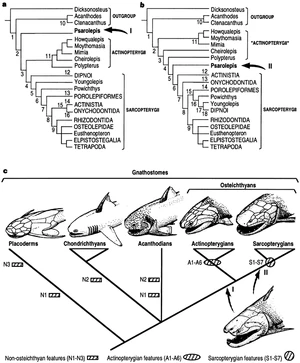| Psarolepis Fossil range: Late Silurian - Early Devonian | |
|---|---|
 | |
| Scientific classification
| |
|
Onychodontida | |
|
Psarolepis | |
| |
Psarolepis is an extinct genus of prehistoric, basal[1] lobe-finned fish which lived 400 - 410 million years ago.
Many relatives of Psarolepis have been found with other groups of fishes[1] and palaeontologists are not certain in which taxonomic group it belongs.
Fossils have been found from the Late Silurian period (Pridoli) to Early Devonian (Lochkovian) in South China of Qujing, Yunnan.
Description[]
The major characteristic of Psarolepis is the pair of parasymphysical tooth whorls, teeth which extend up at the front of the lower jaw. The head was made of several thick dermal plates and covered with deep pock-marks and large pores. Another trait is a large pectoral spine, just in front of the pectoral fin, extending back from the shoulder girdle, and a dorsal spine located in front of a median fin behind the head, which gives the fish a shark-like form.
History[]
Discovery[]
In 1998, a 400-million-year-old fossil from the Silurian and Devonian period was discovered by Zhu and colleagues at the location of Yunnan in South China. This new find was the strange fossil fish Psarolepis.
Most of the Psarolepis specimens were found at the same locality of the Yulongsi Formation (Pridoli), the Xishancun Formation (early Lochkovian) and the Xitun Formation (late Lochkovian).
Classification[]
When Psarolepis was described for the first time, it was assigned to the group of lobe-finned fishes, the sarcopterygians[1]. Palaeontologists were unable to locate Psarolepis in the cladogram with certainty, because they did not know if it was the most primitive lobed-finned fish or the most primitive bony fish.
Because Psarolepis lacks, and at the same time shares, some characteristics of both lobed-finned fish and ray-finned fish, it is considered to be the missing link between the two groups.
Features[]

The head of Psarolepis.
Head[]
The pock-marked head of Psarolepis was made of 14 plates containing a layer of porcelain-like cosmine[2]. Because the cosmine layer obscures the suture lines of the skull, it is difficult to study the exact bone structure. The snout was strangely humped and the nostrils were located above the eyes, which were just above the upper jaw.
Fin Spines[]

The shoulder girdle and pectoral spine of Psarolepis.
The most spectacular findings were the fin spines. Two are known[2]: one extending back from the shoulder girdle and another which is associated with the dorsal fin. These fin spines are found only in primitive jawed fishes and are apparently absent from the most primitive sharks, but present in abundance in more derived forms.
Dentition[]
Psarolepis had teeth at the very front of the snout with large fangs on the tooth plate. Outstanding features are the parasymphysical tooth whorls which place the fish in the order of onychodontida. The premaxilla and the dentary had large inner teeth and irregular array of tiny outer teeth.
Relationships[]

Phylogenetic analysis and the incongruous distribution of Psarolepis characters.
The fossil of Psarolepis from the Upper Silurian to Lower Devonian has shown related features of both actinopterygian and sarcopterygian fishes:
- In the skull, Psarolepis shows a mix of actinopterygian and sarcopterygian features. In the lower jaw, for example, the teeth are sarcopterygian in showing multiple infoldings[1] and in bearing cosmine.
- The cheek bones and the shoulder girdle, however, seem to share features of both groups.
- The pectoral spine extending back from the shoulder girdle, is also found in some placoderms and acanthodians. Furthermore, the median spine, located behind the head, is known in sharks and acanthodians. These two features, however, have not been seen in other bony fish[1].
References[]
- ^ a b c d e Michael J. Benton. 2005. Early Palaeozoic Fishes. Vertebrate Palaeontology.Blackwell Publishing. pps. 65. isbn=0632056371
- ^ a b Palaeos 140.100 Sarcopterygii: Psarolepis